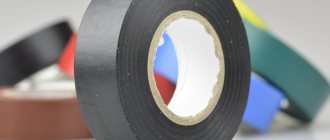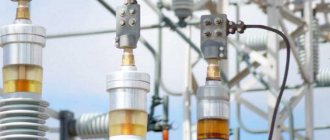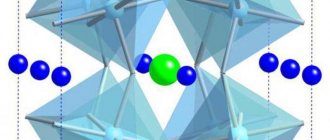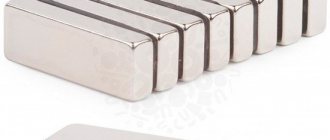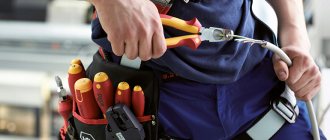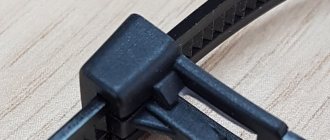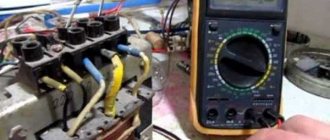Some materials used in electrical devices and power supply circuits have dielectric properties, that is, they have a high resistance to current. This ability allows them not to pass current, and therefore they are used to create insulation for live parts. Electrical insulating materials are designed not only to separate live parts, but also to create protection from the dangerous effects of electric current. For example, power cords for electrical appliances are covered with insulation.
Electrical insulating materials and their applications
Electrical insulating materials are widely used in industry, radio and instrument making, and the development of electrical networks. The normal operation of an electrical device or the safety of the power supply circuit largely depends on the dielectrics used. Certain parameters of a material intended for electrical insulation determine its quality and capabilities.
The use of insulating materials is subject to safety regulations. The integrity of the insulation is the key to safe work with electric current. It is very dangerous to use devices with damaged insulation. Even a small electrical current can have an effect on the human body.
Properties of dielectrics
Electrical insulating materials must have certain properties in order to perform their functions. The main difference between dielectrics and conductors is the large volumetric resistivity (109–1020 ohm cm). The electrical conductivity of conductors is 15 times greater compared to dielectrics. This is due to the fact that insulators by their nature have several times fewer free ions and electrons, which ensure the conductivity of the material. But when the material is heated, there are more of them, which helps to increase current conductivity.
There are active and passive properties of dielectrics. Passive properties are the most important for insulating materials. The dielectric constant of the material should be as small as possible. This allows the insulator not to introduce stray capacitances into the circuit. For a material that is used as a capacitor dielectric, the dielectric constant should, on the contrary, be as large as possible.
Film materials
These materials include lavsan film , fluoroplastic film, film-electrocardboard (electric cardboard covered with an insulating film, such as triacetate), terfan , melinex (polyethylene terephthalate films). These insulating materials have a dielectric strength of up to 200 kV/mm, a tensile strength of 30 kg with a film thickness of 0.05 mm. Their heat resistance reaches and sometimes exceeds 120° C.
Fluoroplastic film
Isolation Options
The main parameters of electrical insulation include electrical strength, electrical resistivity, relative dielectric constant, and dielectric loss angle. When assessing the electrical insulating properties of a material, the dependence of the listed characteristics on the magnitude of electric current and voltage is also taken into account.
Electrical insulating products and materials have a higher electrical strength compared to conductors and semiconductors. Also important for a dielectric is the stability of specific values when heated, increased voltage and other changes.
Dielectric losses
Energy losses in dielectrics are observed both at alternating voltage and at constant voltage, since a through current due to conductivity is detected in the material. At constant voltage, when there is no periodic polarization, the quality of the material is characterized by the values of specific volume and surface resistance. With alternating voltage, it is necessary to use some other characteristic of the quality of the material, since in this case, in addition to through electrical conductivity, a number of additional reasons arise that cause energy losses in the dielectric.
4 pp., 1860 words
Electrochemical processing of materials, its characteristics
... safer and less aggressive than solutions of acids and alkalis. Figure.7 Electrochemical dimensional processing When, for example, sodium nitrate NaNO3 is dissolved in water, dissociation occurs into... precipitation of Me(OH)n hydroxide occurs at certain values of the activity of Me+n and OH- ions in the electrolyte. The amount of converted substances during electrolysis is determined by Faraday’s law mр = ...
- Other characteristics.
Classification of dielectric materials
Depending on the power of the current passing through the conductor, different types of insulation are used, which differ in their capabilities.
By what parameters are electrical insulating materials divided? The classification of dielectrics is based on their state of aggregation (solid, liquid and gaseous) and origin (organic: natural and synthetic, inorganic: natural and artificial). The most common type of solid dielectrics that can be seen on the cords of household appliances or any other electrical appliances.
Solid and liquid dielectrics, in turn, are divided into subgroups. Solid dielectrics include varnished fabrics, laminated plastics and various types of mica. Waxes, oils and liquefied gases are liquid electrical insulating materials. Special gaseous dielectrics are used much less frequently. This type also includes a natural electrical insulator – air. Its use is due not only to the characteristics of air, which make it an excellent dielectric, but also to its cost-effectiveness. The use of air as insulation does not require additional material costs.
Properties of current insulators
The main task of a dielectric is to provide an insulating function. Therefore, as basic operational properties, we can note an increased resistivity, a small dielectric loss tangent and a high breakdown voltage - the already mentioned breakdown. Resistance determines how much a material can prevent the conduction of current under different parameters of the contacting electrical circuit. Dielectric losses, in turn, indicate the influence of the insulator on the performance of the active conductor - normatively, this value should tend to zero, but more often than not, high resistance leads to increased losses in the main circuit. The breakdown properties of electrical insulating materials, which are determined by voltage, are also important. In this case, we can talk about the direct permeability of the target material. Moreover, all of the listed properties are recorded only if the stability of their “operation” over time and at a given temperature has been noted. Sometimes the electric field frequency is also indicated as a stability parameter during testing.
Solid dielectrics
Solid electrical insulating materials are the widest class of dielectrics that are used in various fields. They have different chemical properties, and the dielectric constant ranges from 1 to 50,000.
Solid dielectrics are divided into non-polar, polar and ferroelectrics. Their main differences are in the polarization mechanisms. This class of insulation has properties such as chemical resistance, tracking resistance, and dendrite resistance. Chemical resistance is expressed in the ability to withstand the influence of various aggressive environments (acid, alkali, etc.). Tregging resistance determines the ability to withstand the effects of an electric arc, and dendrite resistance determines the formation of dendrites.
Solid dielectrics are used in various fields of energy. For example, ceramic electrical insulating materials are most often used as line and bushing insulators in substations. Paper, polymers, and fiberglass are used as insulation for electrical devices. For machines and devices, varnishes, cardboard, and compound are most often used.
For use in various operating conditions, insulation is given some special properties by combining different materials: heat resistance, moisture resistance, radiation resistance and frost resistance. Heat-resistant insulators can withstand temperatures up to 700 °C; these include glass and glass-based materials, organosilites and some polymers. The moisture-resistant and tropical-resistant material is fluoroplastic, which is non-hygroscopic and hydrophobic.
Radiation resistant insulation is used in devices containing atomic elements. This includes inorganic films, some types of polymers, fiberglass and mica-based materials. Frost-resistant insulation is considered to be one that does not lose its properties at temperatures down to -90 °C. Special requirements are placed on insulation intended for devices operating in space or vacuum conditions. For these purposes, vacuum-dense materials are used, which include special ceramics.
Compound as the main dielectric in radio engineering
Quite practical to use and inexpensive method of dielectric protection. The compound is applied to the work area, after which it hardens, fully acquiring its basic functional qualities. At the same time, it cannot be said that compounds are necessarily solid electrical insulating materials, since there are also liquid-type varieties. Even in working condition they do not harden. There are also pouring and impregnating types of this material. A distinctive feature of all compounds is the complete absence of solvents in the composition. This makes it possible to provide delicate impregnation of complex electromechanical parts and devices.
Liquid dielectrics
Liquid electrical insulating materials are often used in electrical machines and apparatus. In a transformer, oil plays the role of insulation. Liquid dielectrics also include liquefied gases, unsaturated vaseline and paraffin oils, polyorganosiloxanes, distilled water (purified from salts and impurities).
The main characteristics of liquid dielectrics are dielectric constant, electrical strength and electrical conductivity. Also, the electrical parameters of dielectrics largely depend on the degree of their purification. Solid impurities can increase the electrical conductivity of liquids due to the proliferation of free ions and electrons. Purification of liquids by distillation, ion exchange, etc. leads to an increase in the electrical strength of the material, thereby reducing its electrical conductivity.
Liquid dielectrics are divided into three groups:
- petroleum oils;
- vegetable oils;
- synthetic fluids.
The most commonly used petroleum oils are transformer, cable and capacitor oils. Synthetic fluids (organosilicon and organofluorine compounds) are also used in apparatus construction. For example, organosilicon compounds are frost-resistant and hygroscopic, therefore they are used as an insulator in small transformers, but their cost is higher than the price of petroleum oils.
Vegetable oils are practically not used as insulating materials in electrical insulating technology. These include castor oil, flaxseed oil, hemp oil and tung oil. These materials are low-polarity dielectrics and are used mainly for impregnation of paper capacitors and as a film-forming substance in electrical insulating varnishes, paints, and enamels.
Plan.
1. Introduction
Properties of electrical insulating materials.
2. Main part
Electrical insulating oils (transformer, capacitor, Vaseline, cable).
Liquid synthetic dielectrics.
Vegetable oils.
Natural resins.
Bitumen.
Waxy dielectrics (paraffin, ceresin, petroleum jelly).
- Bibliography
Properties of electrical insulating materials.
A characteristic important for assessing the quality of materials used for protective covers (cable hoses, crimping capacitors, compound fillings, varnish coatings of parts) - moisture permeability
electrical insulating materials, i.e. their ability to pass water vapor through them.
Due to the presence of minute porosity, most materials have measurable moisture permeability. Only for glass, well-fired ceramics and metals, moisture permeability is almost zero.
It is possible to determine the amount of moisture m (in micrograms) passing during time = 556; through a surface area S [cm 2 ] of a layer of insulating material with a thickness h [cm] under the influence of the difference in water vapor pressure p1 and p2 [mm. rt. Art. ] on both sides of the layer, according to the formula:
m=P
This equation is similar to the equation for the passage of electric current through a body; the pressure difference (р1 - р2) is similar to the potential difference, m/t is the current value, and h/ПS is the body resistance; coefficient P, similar to specific volumetric conductivity, is the moisture permeability of a given material.
Moisture permeability for different materials varies widely. For example: for paraffin the value of P is 0.0007; for polystyrene - 0.03; for cellulose triacetate - about 1 μg
/(cm-h - mm Hg).
To reduce the moisture permeability of porous insulating materials, their impregnation
. It must be remembered that impregnation of fibrous cellulose materials and other porous organic dielectrics only slows down the wetting of the material without affecting the value = 554; after prolonged exposure to humidity. This is due to the fact that the molecules of impregnating substances, which have very large sizes compared to the size of water molecules, are not able to create complete impermeability of the pores of the material for moisture, and they cannot penetrate into the smallest pores of the impregnated material at all.
In tropical conditions, with prolonged use of electrical equipment, especially on organic dielectrics, mold development is observed. Mold worsens: the specific surface resistance of dielectrics, leads to increased losses and deterioration of the mechanical strength of the insulation, and causes corrosion of metal parts in contact with it.
Electrical insulating materials and various electrical products are tested for tropical resistance
, maintaining for a long time at a temperature of 40 - 500C in air saturated with water vapor, and under the influence of mold cultures (the exact conditions of these tests are established by the International Electrotechnical Commission), after which the degree of deterioration in the electrical and other properties of the test samples is determined and the intensity of mold growth on them is noted .
In order to increase the mold resistance of organic electrical insulation, fungicides are added to its composition, i.e. substances that are toxic to mold fungi and inhibit their development, or the insulation is coated with varnish containing fungicides. There are a large number of fungicide formulations suitable for introduction into certain electrical insulating materials. Potent fungicides include, in particular, some organic compounds containing nitrogen, chlorine, and mercury.
The most resistant to mold formation are inorganic dielectrics - ceramics, glass, mica, silicone materials and some organic ones, such as epoxy resins, fluoroplastic - 4, polyethylene, polystyrene.
The most vulnerable to mold development are cellulose materials, including impregnated ones (getinax, textolite), rosin, oil varnishes, etc.
In some cases, transportation and storage in warehouses in tropical conditions are dangerous for electrical insulating and other materials. You also have to take into account the possibility of damage to electrical insulation and cable sheaths by termites and animals.
Electrical insulating oils.
Transformer oil,
Of all liquid electrical insulating materials, it is most widely used in electrical engineering; it is used to fill power transformers.
It is used: firstly, to fill pores in fibrous insulation, as well as the gaps between the winding wires and between the windings and the transformer tank, significantly increasing the electrical strength of the insulation;
secondly, it improves the removal of heat generated due to losses in the windings and core of the transformer. Only some power and instrument transformers are made without oil filling (“dry transformers”);
thirdly for the manufacture of high voltage oil switches. In these devices, the rupture of the electric arc between the divergent contacts of the switch occurs in the oil or in gases under high pressure released by the oil under the influence of the high temperature of the arc; this helps to cool the arc channel and quickly extinguish it.
← ctrl Prev. Track. ctrl →
Pages: 1
Tags: liquids, capacitors, materials, insulation, impregnation
Gaseous dielectrics
The most common gaseous dielectrics are air, nitrogen, hydrogen and SF6 gas. Electrical insulating gases are divided into natural and artificial. Natural air includes air, which is used as insulation between live parts of power lines and electrical machines. As an insulator, air has disadvantages that make it impossible to use in sealed devices. Due to the presence of a high concentration of oxygen, air is an oxidizing agent, and in inhomogeneous fields the low electrical strength of air appears.
Nitrogen is used as insulation in power transformers and high-voltage cables. Hydrogen, in addition to being an electrical insulating material, is also a forced cooling agent, so it is often used in electrical machines. In sealed installations, SF6 gas is most often used. Filling with SF6 gas makes the device explosion-proof. It is used in high-voltage circuit breakers due to its arc-extinguishing properties.
Organic dielectrics
Organic dielectric materials are divided into natural and synthetic. Natural organic dielectrics are currently used extremely rarely, so the production of synthetic ones is increasingly expanding, thereby reducing their cost.
Natural organic dielectrics include cellulose, rubber, paraffin and vegetable oils (castor oil). The majority of synthetic organic dielectrics are various plastics and elastomers, often used in electrical household appliances and other equipment.
Inorganic dielectrics
Inorganic dielectric materials are divided into natural and artificial. The most common natural material is mica, which is chemical and thermal resistant. Phlogopite and muscovite are also used for electrical insulation.
Artificial inorganic dielectrics include glass and materials based on it, as well as porcelain and ceramics. Depending on the application, the artificial dielectric can be given special properties. For example, for bushings, feldspathic ceramics are used, which have a high dielectric loss tangent.
Fibrous electrical insulating materials
Fibrous materials are often used for insulation in electrical devices and machines. These include materials of plant origin (rubber, cellulose, fabrics), synthetic textiles (nylon, nylon), as well as materials made of polystyrene, polyamide, etc.
Organic fibrous materials are highly hygroscopic, so they are rarely used without special impregnation.
Recently, instead of organic materials, synthetic fiber insulation has been used, which has a higher level of heat resistance. These include glass fiber and asbestos. Glass fiber is impregnated with various varnishes and resins to increase its hydrophobic properties. Asbestos fiber has low mechanical strength, so cotton fiber is often added to it.
Source - fb.ru
Thermal insulation, wind and sound insulation
Thermal insulation or thermal insulation building materials GOST R 52953-2008 are used to reduce heat loss from the ceiling, floor and walls. They can be used for both exterior and interior decoration in order to reduce the thermal conductivity of the building. This property is inherent in them due to their special design, which implies high porosity and density.
Photo - mineral wool
There are the following main types of thermal insulation:
- Organic or mineral. This is recycled agricultural waste. They can come in the form of recycled wood, peat and even plastic. The most famous are polystyrene foam, fiberboard, chipboard and other composite coatings;
- Inorganic. These are panels made entirely of synthetic fibers. Mineral wool, pressed wool, aerated concrete, foam glass, ceramic fiber for stoves;
Photo - ceramic fiber - Mixed. This includes coatings that are made by combining mineral and inorganic fibers. Arbolite, fiberboard, refractory brick. They are often heavy, so they are rarely used for finishing an apartment in a multi-story building, but all types of mixed panels are fireproof.
Despite the fact that organic finishing coatings have many advantages, now they are rarely used for insulating facades, because they have low fire resistance. They are mainly used as insulating materials for gas pipelines, water supply systems and individual water pipes.
Photo - combined membrane film
Wind barrier films are often identified with thermal insulation films, but they serve a slightly different purpose. These panels are represented by film membranes, the main purpose of which is to stop the air flow and prevent it from entering the room. Coatings of this type are often used for wooden houses (which have a high level of porosity), protecting floors and roofs from blowing.
Photo - Windproofing films
Windproofing materials are very similar to vapor barrier materials, and they are represented by polyethylene foam, membrane, diffusion films, the winding of which requires the use of special soft disks. By the way, insulation, depending on the material from which it is made, can act as a wind insulator.
Let's look at the prices for the insulating material VPE Comfort 3 mm Lavsan (roll products):
| City | Cost m2, USD e. |
| Ekaterinburg | 0,5 |
| Irkutsk | 0,5 |
| Moscow | 0,7 |
| St. Petersburg (SPb) | 0,7 |
| Samara | 0,5 |
| Ufa | 0,5 |
In addition to Lavsan, you can also buy insulating protective materials produced by TPK Baikal, Ekaterinburg Plant (EZIM) and Global Thermal.
